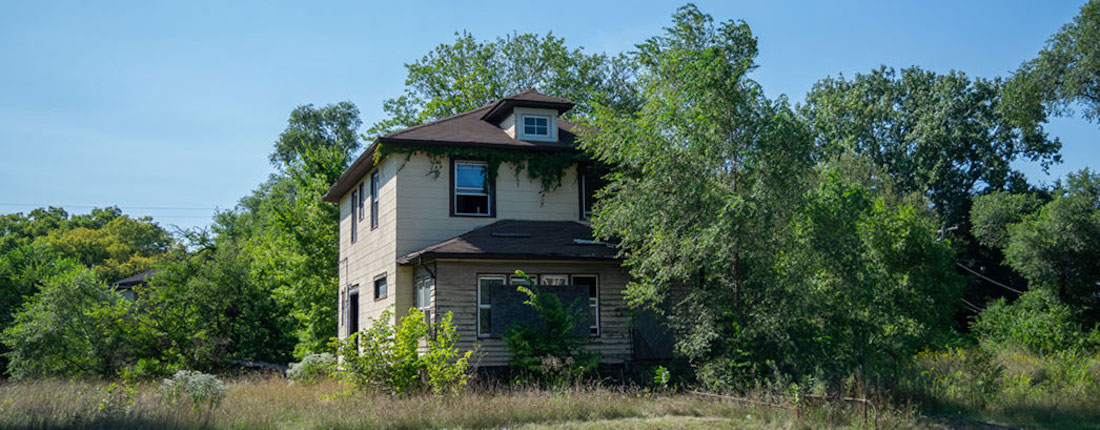Topic(s): ARPA, Climate Resilience, Code Enforcement System, Community Revitalization, Creative Placemaking, Delinquent Tax Enforcement, Land Banks, Parcel Data & Neighborhood Markets, Vacant Land Stewardship
How Vacant and Abandoned Buildings Affect Communities
April 10, 2024

How Vacant and Abandoned Buildings Harm Public Health
- Physical health: Individuals living in substandard housing can be exposed to dangerous toxins such as mold, lead, and asbestos, increasing the risk for asthma, cardiovascular disease, increased aggression, learning disabilities, sexually transmitted diseases, and poor health outcomes.
- Emotional wellbeing: Visual evidence of vacancy and neighborhood disinvestment—such as boarded up properties, trash and dumping, and overgrown weeds—has been shown to harm the mental health of neighbors, putting them at greater risk of sadness, depression, stress, and elevated rates of intentional injury.
- Violence and crime: Studies have shown that violent crime, including assaults and gun-related crimes, increase in disinvested neighborhoods with vacant and abandoned properties.
How Vacant and Abandoned Buildings Harm Individual Wealth
- Property equity: Owning a property is often an individual’s greatest investment and financial asset. Research has consistently shown that vacant, abandoned, and deteriorated properties reduce the value of surrounding properties, leading to decreases in owners’ equity and personal wealth. For example, In Cleveland, Ohio, properties within 500 feet of a vacant, tax-delinquent, and foreclosed property lost 9.4 percent of their value.
- Financial liabilities: Homeowners within close proximity to abandoned properties are often charged higher insurance premiums or even face policy cancellations because of the unstable nature of the neighborhood created by the vacant properties leaving homeowners with greater financial liabilities.
How Vacant and Abandoned Buildings Harm Public Finances
- Municipal revenue: Property taxes are typically the largest source of revenue for local governments. Research has shown vacant and abandoned properties lead to a decrease in taxable values of surrounding properties and increase the likelihood of mortgage and tax foreclosures nearby creating a harmful domino effect that creates revenue challenges for local governments. For example, the total costs of distressed vacant properties in Atlanta, Georgia, range from $55 million to $153 million in lost property values. This translates into lost property tax revenues of $1 million to $2.7 million annually.
- Maintenance and abatement costs: Local governments incur the costs of remedying nuisances and unsafe conditions, including boarding and securing structures, cutting grass, removing trash and debris, and demolishing unsafe structures. For instance, Toledo, Ohio spent $3.8 million in a single year on services related to VAD properties, including $1 million on code enforcement, $800,000 on nuisance abatement, $600,000 on police dispatch, and $1.4 million on fire dispatch.
- Public safety costs: Higher violent and property crime rates and the associated costs to dispatch police and fire services to respond to these crimes are commonly associated with vacant and abandoned properties. For example, a study in Austin, Texas found that “blocks with unsecured [vacant] buildings had 3.2 times as many drug calls to police, 1.8 times as many theft calls, and twice the number of violent calls” as blocks without vacant buildings.
What Happens if You Do Nothing About Vacant and Abandoned Properties?
The costs of doing nothing about abandoned buildings and vacant lots is significant. The longer an abandoned house remains vacant, for example, the more harm it causes its neighbors and neighborhood and the more resources it drains from the community. As it deteriorates because of exposure to the elements with no maintenance, the cost of repair and restoration increases even more, making it less likely for it to be acquired by a new, responsible owner.
Solutions to Vacant and Abandoned Buildings and Lots
Revitalizing vacant, abandoned, and deteriorated properties is a complicated process that takes time, but it saves communities resources and improves the health, wealth, and wellbeing of neighbors and neighborhoods. Proven strategies that the Center for Community Progress advocates for include:
- Land banks: Public entities whose sole purpose is to acquire and temporarily hold and take care of vacant and abandoned properties until they can be transferred to new owners
- Vacant land stewardship: The process of repurposing and maintaining vacant lots
- Creative placemaking: Using art, culture, and intentional community development to activate spaces
- Strategic code enforcement: Improving the process local governments use to enforce state and local laws, codes, or ordinances pertaining to housing, building, or health standards
- Delinquent property tax enforcement: Improving state and local laws that deal with delinquent property taxes (e.g., so vacant properties don’t get “stuck” in a cycle of tax lien sales)
Communities nationwide are reversing the harms of vacant homes and abandoned properties by implementing proven solutions that support public health, safety, and local economies. Together, we can turn vacanat spaces into opportunities for vibrant, thriving neighborhoods.
If you’re struggling with vacant, abandoned, and deteriorated properties in your community, check out our free online resources, webinars, and publications. Local governments should contact the Center for Community Progress at [email protected] for tailored solutions to assess the state of vacancy in your community and recommend policy and practice recommendations that revitalize neighborhoods.
Subscribe to join 14,000 community development leaders getting the latest resources from top experts on vacant property revitalization.

